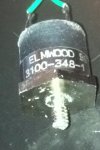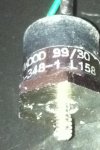IronJungle
Senior Member
I hate to do this because it always ends with a google page slap. That said, I have googled away and still can't find a datasheet. I throw myself on the mercy of the forum and all it's friendly engineering snarkiness. 
I unscrewed four of these from a BIG heat sink. The original product was used to calibrate high end DC power supplies (also yielded some nice precision 1/2 ohm and 1 ohm resistors).
Three pics attached. The markings show ELMWOOD 99/30 3100-1 L158. It is a two lead device. I thinking RTD [maybe], but would like a datasheet.
Any help?


I unscrewed four of these from a BIG heat sink. The original product was used to calibrate high end DC power supplies (also yielded some nice precision 1/2 ohm and 1 ohm resistors).
Three pics attached. The markings show ELMWOOD 99/30 3100-1 L158. It is a two lead device. I thinking RTD [maybe], but would like a datasheet.
Any help?


